Dog Harness
Yun; Yeu Hoon
U.S. patent application number 16/174001 was filed with the patent office on 2019-02-28 for dog harness. The applicant listed for this patent is Yeu Hoon Yun. Invention is credited to Yeu Hoon Yun.
| Application Number | 20190059332 16/174001 |
| Document ID | / |
| Family ID | 59787574 |
| Filed Date | 2019-02-28 |
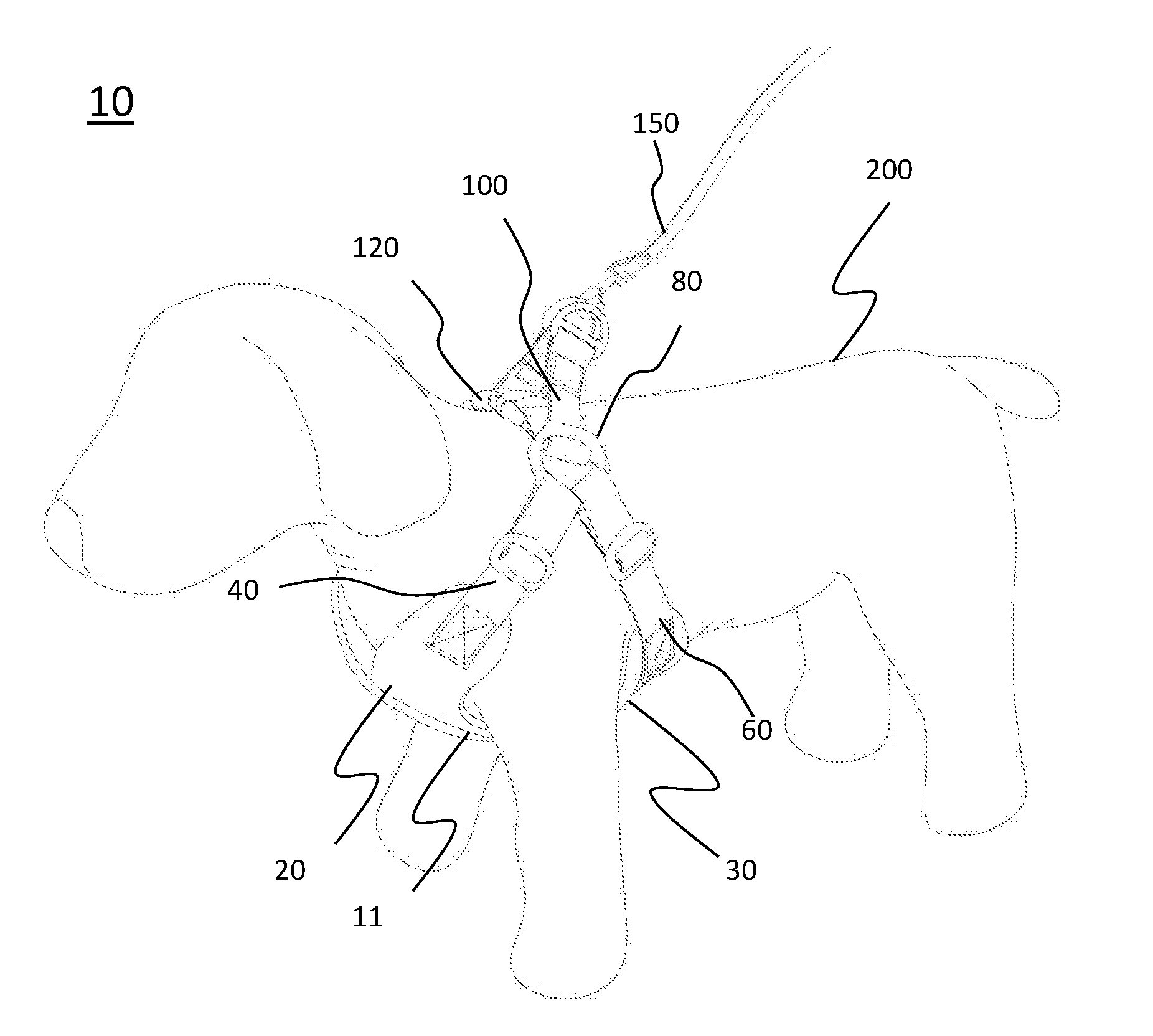



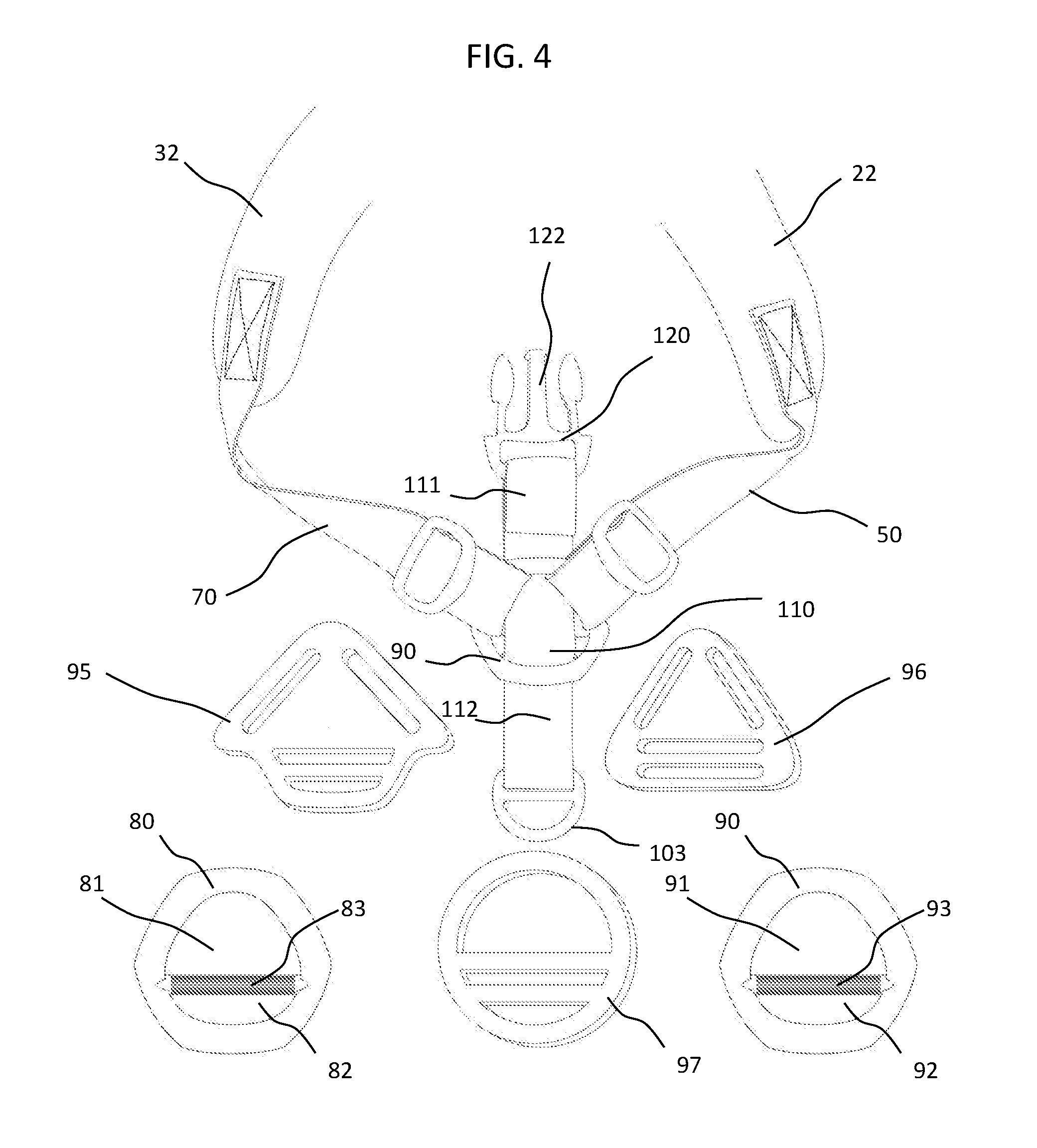
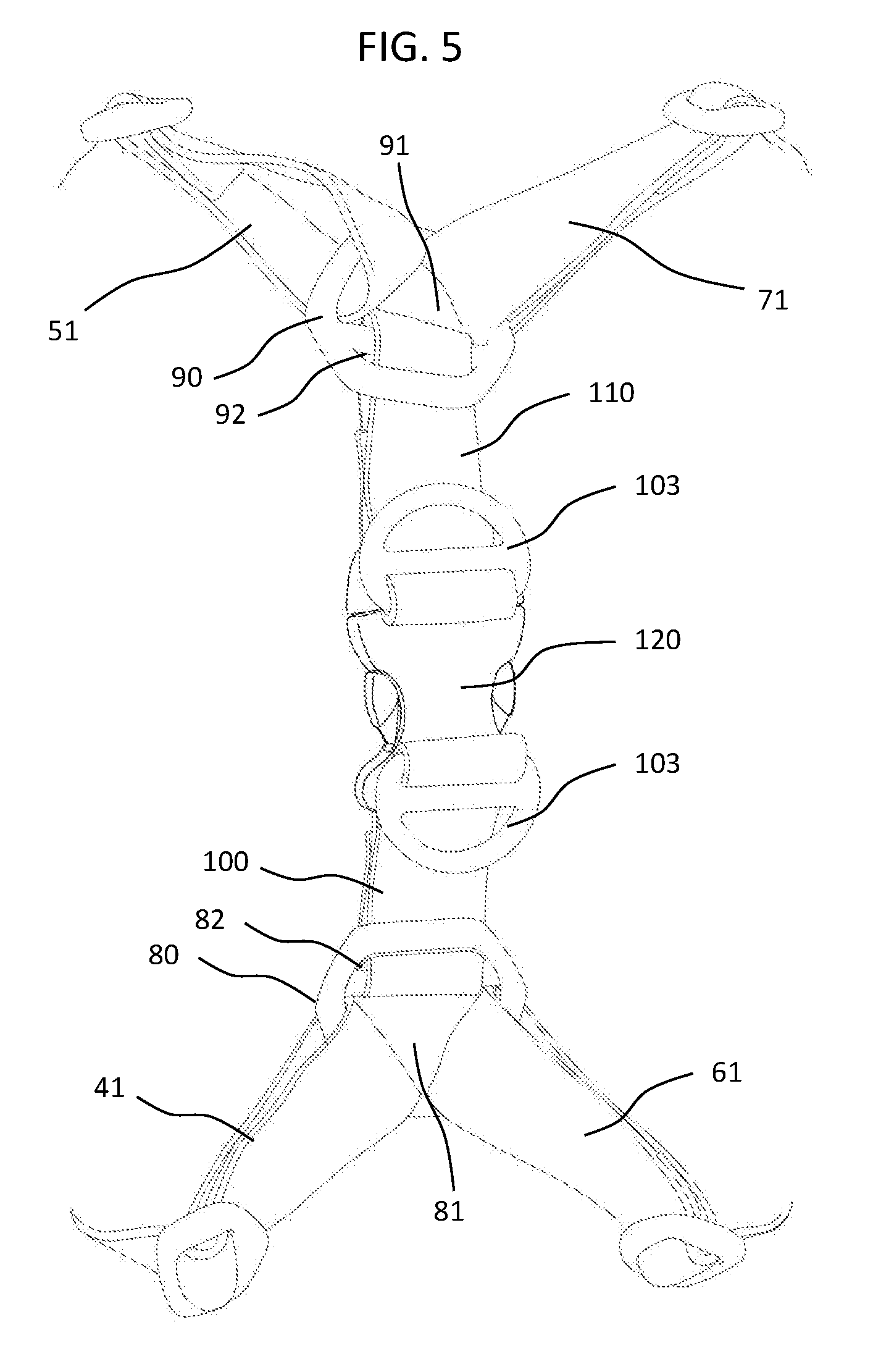

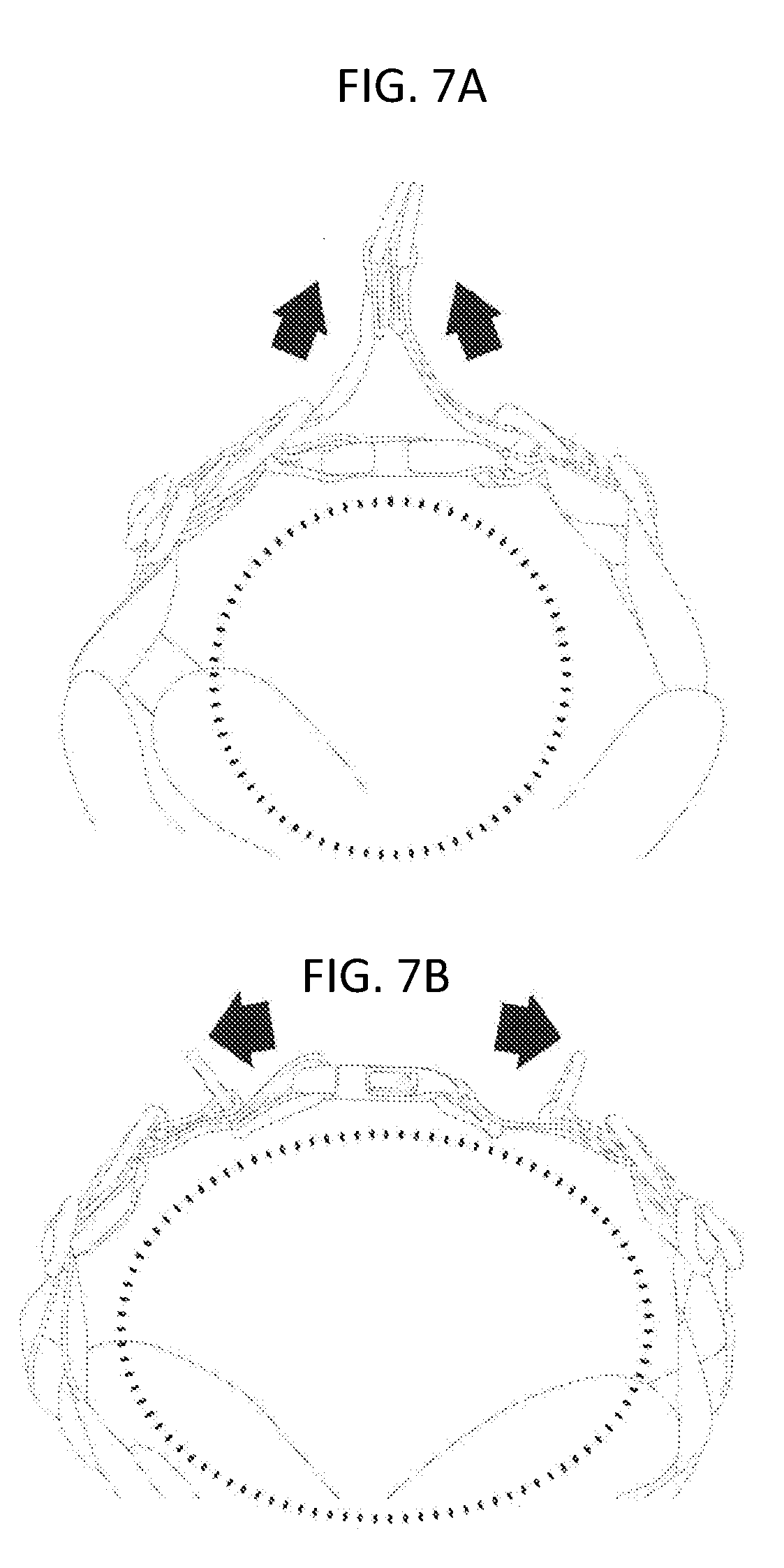
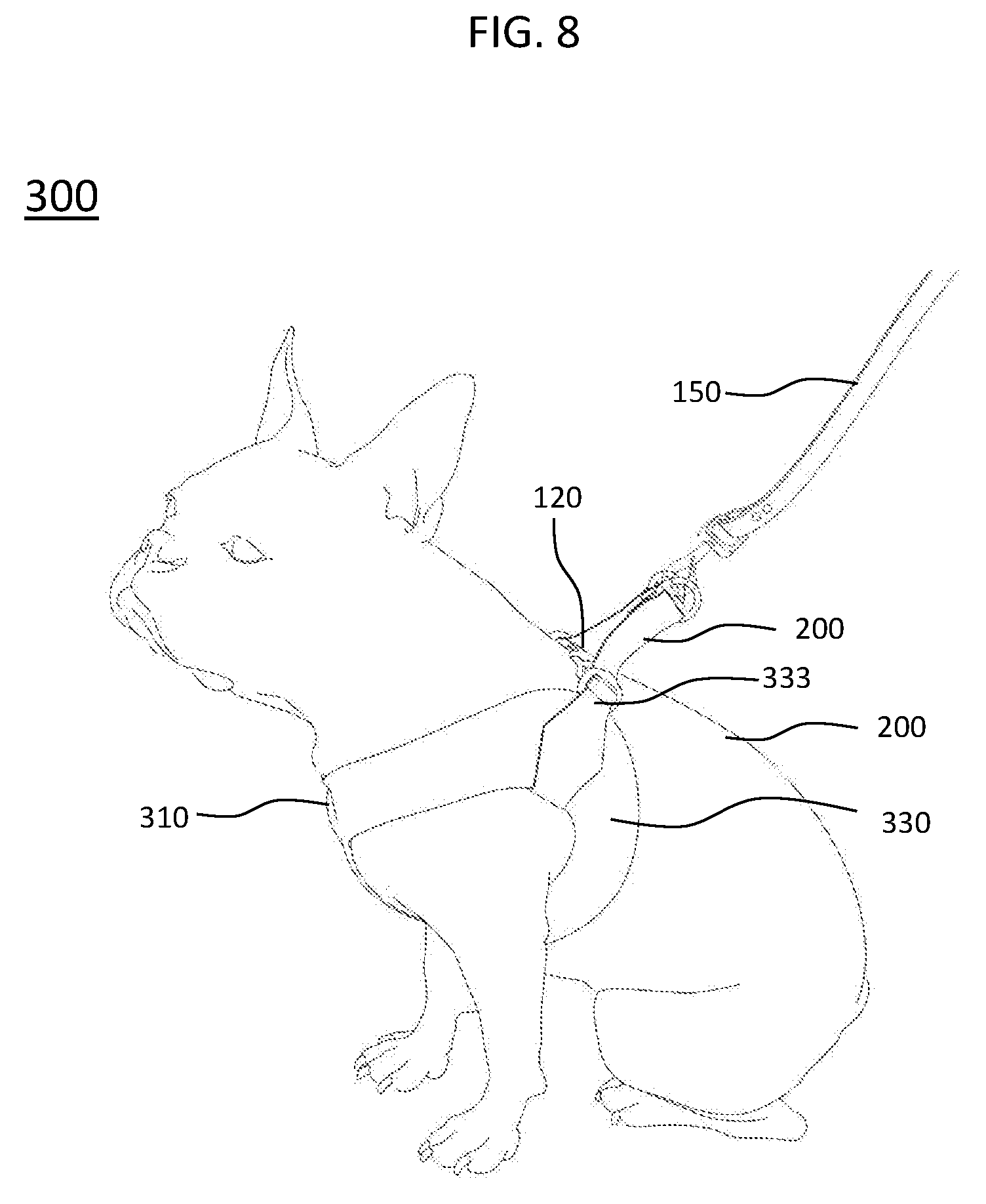

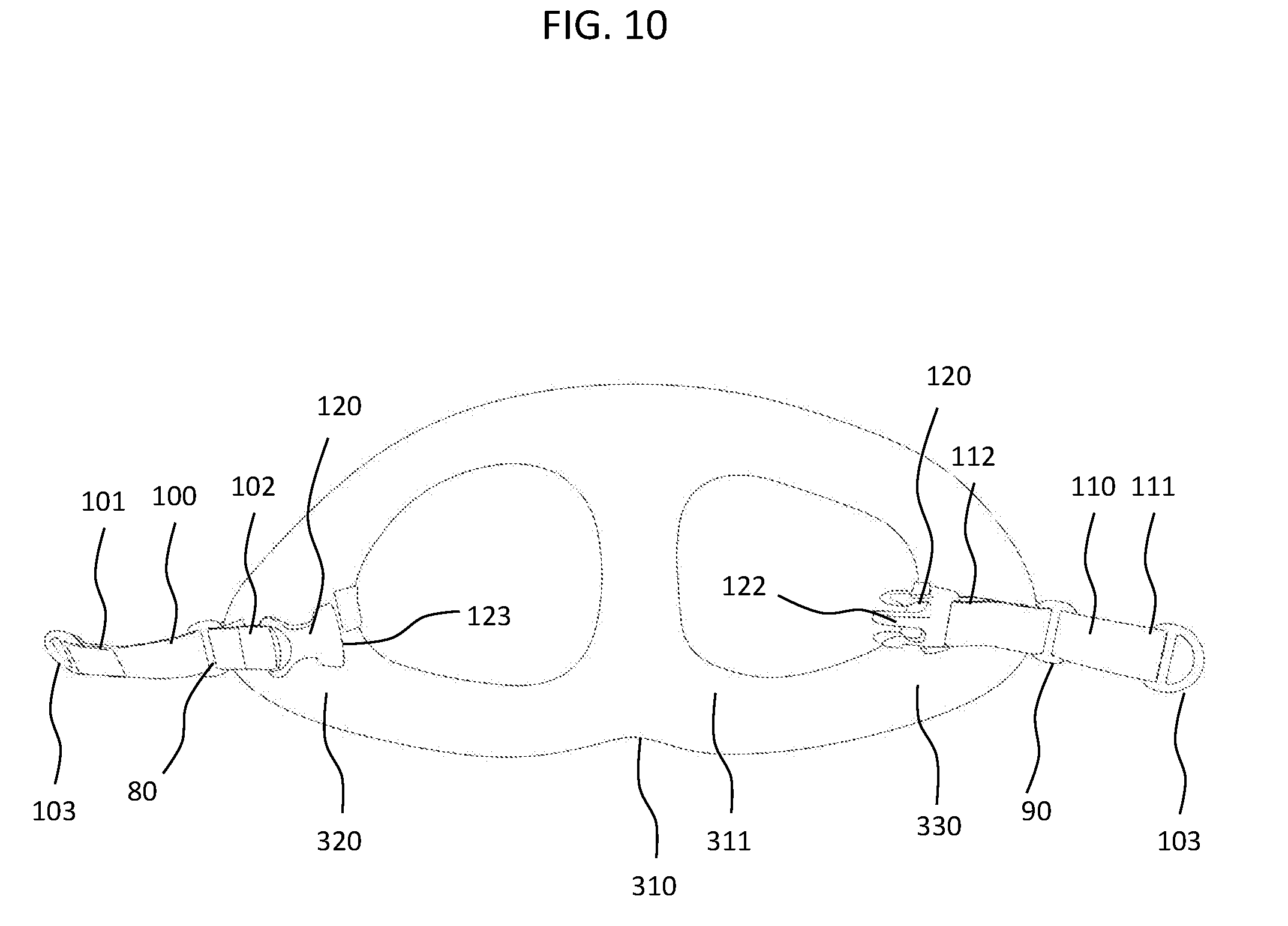
| United States Patent Application | 20190059332 |
| Kind Code | A1 |
| Yun; Yeu Hoon | February 28, 2019 |
DOG HARNESS
Abstract
A dog harness includes a harness body, having a front potion and a rear potion, first and second front straps, first and second rear straps, first and second coupling members, first and second leash straps and a connecting means, wherein the first leash strap loops through the first coupling member such that the first leash strap is adapted to move relative to the first coupling member, wherein the second leash strap loops through the second coupling member such that the second leash strap is adapted to move relative to the second coupling member.
| Inventors: | Yun; Yeu Hoon; (Los Angeles, CA) | ||||||||||
| Applicant: |
|
||||||||||
|---|---|---|---|---|---|---|---|---|---|---|---|
| Family ID: | 59787574 | ||||||||||
| Appl. No.: | 16/174001 | ||||||||||
| Filed: | October 29, 2018 |
Related U.S. Patent Documents
| Application Number | Filing Date | Patent Number | ||
|---|---|---|---|---|
| 15068626 | Mar 13, 2016 | 10130076 | ||
| 16174001 | ||||
| Current U.S. Class: | 1/1 |
| Current CPC Class: | A01K 27/002 20130101; A01K 27/005 20130101 |
| International Class: | A01K 27/00 20060101 A01K027/00 |
Claims
1. A dog harness comprising: a main body being adapted to be positioned on the dog's torso; a first coupling member having an opening, wherein the first coupling member is coupled or attached to a first edge portion of the main body; a second coupling member having an opening, wherein the second coupling member is coupled or attached to a second edge portion of the main body; and a leash strap, having first and second ends, wherein each of the first and second ends of the leash strap is adapted to be connected to a leash, wherein the leash strap loops through the first coupling member and the second coupling member such that the leash strap is adapted to move though the first coupling member and the second coupling member.
2. The dog harness of claim 1, wherein the leash strap further comprises a stop, and wherein the stop is fixedly attached to about the middle of the leash strap.
3. The dog harness of claim 2, wherein the stop of the leash strap cannot pass through the first coupling member or the second coupling member.
4. The dog harness of claim 3, wherein a distance between the first coupling member and the second coupling member shortens when the first and second coupling members contact with the stop by pulling the leash and the distance does not shorten when the main body tightens the dog's torso by pulling the leash.
5. The dog harness of claim 2, wherein the stop is a connecting means.
6. The dog harness of claim 5, wherein the connecting means are a two-piece buckle type fasteners or a breakaway buckle.
7. The dog harness of claim 1, wherein the first coupling member or the second coupling member is a ring.
8. The dog harness of claim 7, wherein the ring is a hexagon-shaped ring having openings, a triangle-shaped ring having openings or a circle-shaped ring having openings.
9. A dog harness comprising: a main body being adapted to be positioned on the dog's torso; a first coupling member having an opening of the first coupling member, wherein the first coupling member is coupled or attached to a first edge portion of the main body; a second coupling member having an opening of the second coupling member, wherein the second coupling member is coupled or attached to a second edge portion of the main body; and a leash strap having first and second ends; and a connecting means, having first and second members, wherein the first member of the connecting means is fixedly attached to the first end of the leash strap and wherein the second member of the connecting means is fixedly attached to the second end of the connecting means, wherein the leash strap is enclosed when the first member and the second member are coupled, wherein the leash strap is adapted to move though the first coupling member and the second coupling member, wherein the connecting means contacts the dog's torso when the first member and the second member are coupled, and wherein the leash strap is adapted to be connected to a leash.
10. The dog harness of claim 9, wherein the first member of the connecting means cannot pass through the first coupling member, and wherein the second member of the connecting means cannot pass through the second coupling member.
11. The dog harness of claim 10, wherein the connecting means are a two-piece buckle type fasteners or a breakaway buckle.
12. The dog harness of claim 9, wherein the first coupling member or the second coupling member is a ring.
13. The dog harness of claim 12, wherein the ring is a hexagon-shaped ring having openings, a triangle-shaped ring having openings or a circle-shaped ring having openings.
14. A dog harness comprising: a main body being adapted to be positioned on the dog's torso; a first coupling member coupled or attached to a first edge portion of the main body; a second coupling member coupled or attached to a second edge portion of the main body; and a leash strap, having a stop, first and second ends of the leash strap, wherein each of the first and second ends of the leash strap is adapted to be connected to a leash, wherein the leash strap loops through the first coupling member and the second coupling member such that the leash strap is adapted to move though the first coupling member and the second coupling member, and wherein a distance between the first coupling member and the second coupling member shortens when the first and second coupling members contact with the stop by pulling the leash and the distance does not shorten when the main body tightens the dog's torso by pulling the leash.
15. The dog harness of claim 14, wherein the stop is fixedly attached to the first and second ends of the leash strap.
16. The dog harness of claim 15, wherein the stop of the leach strap cannot pass through the first coupling member or the second coupling member.
17. The dog harness of claim 16, wherein the stop is a connecting means and wherein the first and second coupling members is a ring, wherein the connecting means are a two-piece buckle type fasteners or a breakaway buckle, and wherein the ring is a hexagon-shaped ring having openings, a triangle-shaped ring having openings or a circle-shaped ring having openings.
Description
CROSS-REFERENCE TO RELATED APPLICATIONS
[0001] This application is a Continuation application of and claims priority to U.S. patent application Ser. No. 15/068,626, filed Mar. 13, 2016, the disclosure of which is incorporated herein in its entirety by reference thereto.
FIELD OF THE INVENTION
[0002] The present invention relates to a harness for a dog, and more particularly, a dog harness having a tightening or adjusting means for preventing a dog from escaping the dog harness. The dog harness tightens when the dog tries to move forwards or backwards against the pulling force of the leash held by a dog owner, thereby preventing the dog slipping out of and escaping from the dog harness. Once the dog stops applying pressure against the pulling force of the leash held by the user, the dog harness releases back to make the dog feel comfortable.
BACKGROUND OF THE INVENTION
[0003] A dog harness is a piece of equipment for dogs, worn around a dog's torso and/or neck. The dog harness usually has a loop structure, which surrounds a dog's torso and/or neck, and a leash attachment means to be connected to a leash. The dog harness and leash are usually used together to restrain or control a dog, commonly used when walking a dog. Instead of the loop structure, a garment may be used to surround a dog's torso, including a dog's chest and/or belly.
[0004] Compared to a collar worn around a neck, a dog harness is better in preventing choking or lowering chance of slipping out of it because of its structure surrounding a dog's torso and neck and thereby distributing force. Thus, a dog harness is growing in popularity among many dog owners, especially for those having smaller breed dogs. The dog harness is also useful for controlling, directing and teaching the dog.
[0005] However, a dog harness is not free from the issue of slipping out. If a dog trying to move forward or backward against the direction of the leash held by a user, a dog harness may become loose and a dog may slip out of it and escape. Especially, when a dog tries hard to move backward against the pulling force of the leash held by a user and lower its head, there may be a room formed and getting bigger between the dog's back of neck and the leash connector connecting the leash and the dog harness, thereby allowing the dog to slip out and escape the dog harness.
[0006] Therefore, to solve the above problems, there is a need for a dog harness having a freely moving leash strap for tightening and fastening the dog's torso when the dog tries to move backwards to escape from the dog harness. This invention is directed to solve these problems and satisfy the long-felt need.
SUMMARY OF THE INVENTION
[0007] The present invention provides a dog harness having a freely moving leash strap for tightening and fastening the dog's torso when the dog tries to move backwards to escape from the dog harness. Once the dog stops to move against a leash, the dog harness begins to be released back.
[0008] The object of the present invention is to provide a dog harness, which includes a harness body comprises an inner surface and an outer surface wherein the inner surface is contact with a torso of a dog, wherein the harness body which includes a front portion, having first and second ends of the front portion, being adapted to be positioned on the dog's torso in front of front legs of the dog; and a rear portion, having first and second ends of the rear portion, being adapted to be positioned on the dog's torso behind the front legs of the dog; a first front strap, having first and second ends of the first front strap; a second front strap, having first and second ends of the second front strap; a first rear strap, having first and second ends of the first rear strap; a second rear strap, having first and second ends of the second rear strap; a first coupling member, having first and second openings of the first coupling member, to couple the first end of the first front strap and the first end of the first rear strap; a second coupling member, having first and second openings of the second coupling member, to couple the first end of the second front strap and the first end of the second rear strap; a first leash strap, having first and second ends of the first leash strap, wherein the first end of the first leash strap is adapted to be connected to a leash; a second leash strap, having first and second ends of the second leash strap, wherein the first end of the second leash strap is adapted to be connected to the leash; and a connecting means, having first and second members, wherein the first member of the connecting means is connected to the second end of the first leash strap and the second member of the connecting means is connected to the second end of the second leash strap; wherein the first leash strap loops through the first coupling member such that the first leash strap is adapted to move relative to the first coupling member; wherein the second leash strap loops through the second coupling member such that the second leash strap is adapted to move relative to the second coupling member.
[0009] Another object of the present invention is to provide a dog harness which includes a harness body, having an inner surface and an outer surface wherein the inner surface is contact with a torso of a dog, wherein the harness body which includes a left portion, having a end of the left portion and a left loop, being adapted to be positioned on the dog's torso and surrounding around a left front leg of the dog, wherein the left loop fixedly attached the end of the left portion; and a right portion, having a end of the right portion and a right loop, being adapted to be positioned on the dog's torso and surrounding around a right front leg of the dog, wherein the right loop fixedly attached the end of the right portion; a first coupling member, having first and second openings of the first coupling member, to couple the left loop of the left portion; a second coupling member, having first and second openings of the second coupling member, to couple the right loop of the left portion; a first leash strap, having first and second ends of the first leash strap, wherein the first end of the first leash strap is adapted to be connected to a leash; a second leash strap, having first and second ends of the second leash strap, wherein the first end of the second leash strap is adapted to be connected to the leash; and a connecting means, having first and second members, wherein the first member of the connecting means is connected to the second end of the first leash strap and the second member of the connecting means is connected to the second end of the second leash strap; wherein the first leash strap loops through the first coupling member such that the first leash strap is adapted to freely move relative to the first coupling member; wherein the second leash strap loops through the second coupling member such that the second leash strap is adapted to freely move relative to the second coupling member.
[0010] The advantages of the present invention are: (1) the present invention provides dog harness having a tightening and releasing structure for preventing a dog from escaping the dog harness especially when the dog tries hard to move backwards to escape from the dog harness; (2) the present invention has a simple structure, but is very effective in preventing slip out; (3) the present invention makes a dog feel comfortable while wearing it; (4) the present invention is easy to manufacture and use; (5) the structure of the present invention is pleasing in appearance and functionally superior; and (6) the dog harness of the present invention is convenient to adjust a dog harness to snugly fit different sizes of a dog.
[0011] Although the present invention is briefly summarized, the fuller understanding of the invention can be obtained by the following drawings, detailed description and appended claims.
BRIEF DESCRIPTION OF THE DRAWINGS
[0012] These and other features, aspects and advantages of the present invention will become better understood with reference to the accompanying drawings, wherein:
[0013] FIG. 1 shows a perspective view of a dog harness according to one embodiment of the present invention fitted to a dog;
[0014] FIG. 2 shows an outer portion perspective view of a dog harness of FIG. 1;
[0015] FIG. 3 shows an inner potion perspective view of the dog harness of FIG. 1;
[0016] FIG. 4 shows a partial view of the dog harness of FIG. 1 with various coupling members;
[0017] FIG. 5 shows another partial view of the dog harness of FIG. 1 when a connection means is connected with each other;
[0018] FIG. 6 shows another partial view of the dog harness of FIG. 1 with various connecting means;
[0019] FIG. 7A shows a front perspective view of the dog harness of FIG. 1 when a leash strap is tightened;
[0020] FIG. 7B shows a front perspective view of the dog harness of FIG. 1 when the leash strap loosens;
[0021] FIG. 8 shows a perspective view of the dog harness of according to another embodiment of the present invention fitted to a dog;
[0022] FIG. 9 shows an outer potion perspective view of a dog harness of FIG. 8; and
[0023] FIG. 10 shows an inner potion perspective view of the dog harness of FIG. 8.
DETAILED DESCRIPTION EMBODIMENTS OF THE INVENTION
[0024] Reference will now be made in detail to the preferred embodiments of the present invention, examples of which are illustrated in the accompanying drawings, which form a part of this disclosure. It is to be understood that this invention is not limited to the specific devices, methods, conditions or parameters described and/or shown herein, and that the terminology used herein is for the purpose of describing particular embodiments by way of example only and is not intended to be limiting of the claimed invention.
[0025] Also, as used in the specification including the appended claims, the singular forms "a", "an", and "the" include the plural, and reference to a particular numerical value includes at least that particular value, unless the context clearly dictates otherwise. Ranges may be expressed herein as from "about" or "approximately" one particular value and/or to "about" or "approximately" another particular value. When such a range is expressed, another embodiment includes from the one particular value and/or to the other particular value. Similarly, when values are expressed as approximations, by use of the antecedent "about", it will be understood that the particular value forms another embodiment.
[0026] The present invention provides a dog harness having a freely moving leash strap for tightening and fastening a dog's torso when the dog tries to move backwards to escape from the dog harness against the pulling force of the leash held by a user. Once the dog stops moving backwards against the pulling force of the leash, the dog harness begins to be released back.
[0027] FIG. 1 shows a perspective view of the dog harness according to one embodiment of the present invention fitted to the dog. FIG. 2 and FIG. 3 respectively show an outer potion and an inner potion of the dog harness of FIG. 1.
[0028] The dog harness 10 of the present invention may comprise a harness body 11, having an inner surface 12 and an outer surface 13 wherein the inner surface 12 may be contact with a torso of a dog 200. The harness body 10 further may comprise a front portion 20, having first and second ends 21, 22 of the front portion 20, may be adapted to be positioned on the dog's torso in front of front legs of the dog 200 and a rear portion 30, having first and second ends 31, 32 of the rear portion 30, may be adapted to be positioned on the dog's torso behind the front legs of the dog 200. A first front strap 40 may include first and second ends 41, 42 of the first front strap 40. A second front strap 50 may include first and second ends 51, 52 of the second front strap 50. A first rear strap 60 may include first and second ends 61, 62 of the first rear strap and a second rear strap 70 may include first and second ends 71, 72 of the second rear strap. A first coupling member 80 may comprise first and second openings 81, 82 of the first coupling member 80, to couple the first end 41 of the first front strap 40 and the first end 61 of the first rear strap 60. A second coupling member 90, having first and second openings 91, 92 of the second coupling member 90, may be coupled the first end 51 of the second front strap 50 and the first end 71 of the second rear strap 70.
[0029] FIG. 4 shows a partial view of the dog harness of FIG. 1 with various coupling members. FIG. 5 shows another partial view of the dog harness of FIG. 1 when a connection means is connected with each other and FIG. 6 shows another partial view of the dog harness of FIG. 1 with various connecting means.
[0030] A first leash strap 100 may comprise first and second ends 101, 102 of the first leash strap 100, wherein the first end 101 of the first leash strap 100 may be adapted to be connected to a leash 150. A second leash strap 110 may include first and second ends 111, 112 of the second leash strap 110, wherein the first end 112 of the second leash strap 110 may be adapted to be connected to the leash 150. A connecting means 120 may comprise first and second members 121, 122, wherein the first member 121 of the connecting means 120 may be connected to the second end 102 of the first leash strap 100 and the second member 122 of the connecting means 120 may be connected to the second end 112 of the second leash strap 110. The first leash strap 100 may loop through the first coupling member 80 such that the first leash strap 100 may be adapted to freely move relative to the first coupling member 80 and the second leash strap 110 may loop through the second coupling member 90 such that the second leash strap 110 may be adapted to freely move relative to the second coupling member 90.
[0031] FIG. 7A shows a front perspective view of the dog harness of FIG. 1 when a leash strap is tightened and FIG. 7B shows a front perspective view of the dog harness of FIG. 1 when the leash strap loosens.
[0032] The first leash strap 100 may be adapted to freely move between a first predetermined position and a second predetermined position relative to the first coupling member 80. The second leash strap 110 may be adapted to freely move between a third predetermined position and a fourth predetermined position relative to the second coupling member 90.
[0033] Because of the structure of freely moving leash straps, the dog harness 10 of the present invention can prevent a dog from slip out or escaping the dog harness 10. Especially, when a dog tries hard to move backward against the pulling force of the leash 150 held by a user and lower its head, there may be a room formed and getting bigger between the dog's back of neck and the leash connector connecting the leash and the dog harness, thereby allowing the dog to slip out and escape the dog harness.
[0034] However, in the present invention, the dog harness is tightened or fastened when the dog tries to move backward against the pulling force of the leash. Once the dog stops moving backwards against the pulling force of the leash, the dog harness begins to be released back.
[0035] Preferably, the first leash strap 100 may pass through the first opening 81 of the first coupling member 80 and may pass back again through in the opposite direction the second opening 82 of the first coupling member 80. But, a D-ring 103 and the connecting means 120 of first and second ends 101, 102 of the first leash strap 100 cannot pass through the second opening 82 of the first opening 80. The second leash strap 110 may pass through the first opening 91 of the first coupling member 90 and may pass back again through in the opposite direction the second opening 92 of the second coupling member 90. But, a D-ring 103 and the connecting means 120 of first and second ends 111, 112 of the first leash strap 110 cannot pass through the second opening 92 of the first opening 90.
[0036] The first coupling member 80 may be a hexagon-shaped ring having openings, a triangle-shaped plate having openings or a circle-shaped ring having openings. The second coupling member 90 may be a hexagon-shaped ring having openings, a triangle-shaped plate having openings or a circle-shaped ring having openings.
[0037] The first end 101 of the first leash straps 100 and the first end 111 of the second leash straps 110 may be received respectively a D-ring 103 connected the leash 150.
[0038] The connecting means 120 may be a two-piece buckle type fasteners or a breakaway buckle. The first member 121 of the connecting means 120 may be a female buckle and the second member 122 of the connecting means 120 may be a male buckle.
[0039] The harness body 10 may be formed in substantially an I-shaped or X-shaped and the harness body 10 may be made of mesh polyester. The first and second front straps 40, 50 further may comprise respectively adjustable slides 43, 53 to adjust length of the first and second front straps 40, 50. The first and second rear straps 60, 70 further may comprise respectively adjustable slides 63, 73 to adjust length of the first and second rear straps 60, 70.
[0040] FIG. 8 shows a perspective view of the dog harness of according to another embodiment of the present invention fitted to a dog. FIG. 9 shows an outer potion perspective view of a dog harness of FIG. 8 and FIG. 10 shows an inner potion perspective view of the dog harness of FIG. 8.
[0041] The dog harness 300 may comprise a harness body 310, having an inner surface 311 and an outer surface 312 wherein the inner surface 311 is contact with a torso of a dog 200. The harness body 310 further may comprise a left portion 320, having a end 321 of the left portion 320 and a left loop 322, may be adapted to be positioned on the dog's torso and surrounding around a left front leg of the dog 200. The left loop 322 may be fixedly attached the end 321 of the left portion 320. A right portion 330, having a end 331 of the right portion 330 and a right loop 332, may be adapted to be positioned on the dog's torso and surrounding around a right front leg of the dog 200. The right loop 332 may be fixedly attached the end 331 of the right portion.
[0042] A first coupling member 80, having first and second openings 81, 82 of the first coupling member 80, may be couple the left loop 322 of the left portion 320. A second coupling member 90, having first and second openings 91, 92 of the second coupling member 90, may be coupled the right loop 332 of the right portion 330.
[0043] A first leash strap 100 may include first and second ends 101, 102 of the first leash strap 100, wherein the first end 101 of the first leash strap 100 may be adapted to be connected to a leash 150. A second leash strap 110 may include first and second ends 111, 112 of the second leash strap 110, wherein the first end 112 of the second leash strap 110 may be adapted to be connected to the leash 150.
[0044] A connecting means 120 may comprise first and second members 121, 122 wherein the first member 121 of the connecting means 120 may be connected to the second end 102 of the first leash strap 100 and the second member 122 of the connecting means 120 may be connected to the second end 112 of the second leash strap 110 wherein the first leash strap 100 may loop through the first coupling member 80 such that the first leash strap 100 may be adapted to freely move relative to the first coupling member 80. The second leash strap 110 may loop through the second coupling member 90 such that the second leash strap 110 may be adapted to freely move relative to the second coupling member 90.
[0045] The first leash strap 100 may be adapted to freely move between a first predetermined position and a second predetermined position relative to the first coupling member 80. The second leash strap 110 may be adapted to freely move between a third predetermined position and a fourth predetermined position relative to the second coupling member 90.
[0046] The first leash strap 100 pass through the first opening 81 of the first coupling member 80 and passes back again through in the opposite direction the second opening 82 of the first coupling member 80. But, a D-ring 103 and the connecting means 120 of first and second ends 101, 102 of the first leash strap 100 cannot pass through the second opening 82 of the first opening 80. The second leash strap 110 may pass through the first opening 91 of the first coupling member 90 and may pass back again through in the opposite direction the second opening 92 of the second coupling member 90. But, a D-ring 103 and the connecting means 120 of first and second ends 111, 112 of the first leash strap 110 cannot pass through the second opening 92 of the first opening 90.
[0047] The first coupling member 80 may be a hexagon-shaped ring having openings or a triangle-shaped plate having openings or a circle-shaped ring having openings. The second coupling member 90 may be a hexagon-shaped ring having openings or a triangle-shaped plate having openings or a circle-shaped ring having openings.
[0048] The first end 101 of the first leash straps 100 and the first end 111 of the second leash straps 110 may be respectively D-rings connected the leash 150. The connecting means 120 may be a two-piece buckle type fasteners or a breakaway buckle. The first member 121 of the connecting means 120 may be a female buckle and the second member 122 of the connecting means 120 is a male buckle. The harness body 310 may be formed in substantially an 8-shaped and may be made of mesh polyester.
[0049] While the invention has been shown and described with reference to different embodiments thereof, it will be appreciated by those skilled in the art that variations in form, detail, compositions and operation may be made without departing from the spirit and scope of the invention as defined by the accompanying claims.
* * * * *
D00000

D00001

D00002

D00003

D00004

D00005

D00006

D00007

D00008

D00009

D00010

XML
uspto.report is an independent third-party trademark research tool that is not affiliated, endorsed, or sponsored by the United States Patent and Trademark Office (USPTO) or any other governmental organization. The information provided by uspto.report is based on publicly available data at the time of writing and is intended for informational purposes only.
While we strive to provide accurate and up-to-date information, we do not guarantee the accuracy, completeness, reliability, or suitability of the information displayed on this site. The use of this site is at your own risk. Any reliance you place on such information is therefore strictly at your own risk.
All official trademark data, including owner information, should be verified by visiting the official USPTO website at www.uspto.gov. This site is not intended to replace professional legal advice and should not be used as a substitute for consulting with a legal professional who is knowledgeable about trademark law.